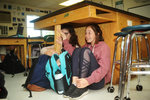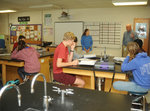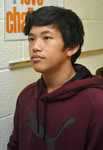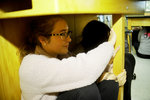




SILER CITY — At 10:17 a.m. last Thursday, Oct. 17, a virtual earthquake shook the southeastern United States and an estimated 350,000 students throughout the region reacted.
Among them were the students in Beth Vaughn’s high school science class at the Chatham Center for Innovation, who momentarily stopped their mid-morning studies to calmly take cover under their desks and grab hold of something steady.
It was, of course, a drill; but an important one, said Brian Haines, a spokesman for the N.C. Dept. of Public Safety, which spearheaded statewide participation.
“One of our goals here at Emergency Management,” said Haines, “is to help people prepare for different events that may occur: hurricanes, tornadoes, earthquakes.”
Called the Great Southeast Shakeout, and billed as the world’s largest earthquake drill, last week’s practice run was part of that planning process.
“North Carolina itself is not highly earthquake-prone,” Haines acknowledged, though earthquakes do occur in Tar Heel State, particularly the western portion.
And knowing what to do should the earth underfoot ever actually move is smart, Haines said.
The potentially life-saving steps — followed exactly by Vaughn’s science students — are easy: Drop, cover, and hold on.
“These simple steps allow you to get down before you’re thrown to the ground, provide protection from falling or flying items, and increase your chances of surviving a building collapse,” advises a release from the Dept. of Public Safety. “By identifying places you can shelter safely in your home or workplace and by practicing going to those places, you increase the likelihood of surviving an earthquake.”
The drill is part of Chatham County Schools’ overall safety program, for students and faculty alike.
“From a safety standpoint, we try to be proactive so when the real deal happens we’re prepared,” said John McCann, the county school system’s public information officer. “In that spirit of preparedness, we’re always drilling, and getting advice from the experts, because you never know.”
Bobby Dixon, principal of the Chatham Center for Innovation, which houses Chatham County Schools’ Early College program, said students are no strangers to drills. Periodically, they practice fire drills, lockdown drills and tornado drills.
Students take them seriously, he said.
“They know it’s for their safety,” said Dixon, “and they know it’s good practice.”
At the appointed time last Thursday — joining an estimated 2.3 million people across the southeastern United States — the students went into earthquake mode.
“We’re going to pretend the classroom is shaking,” Dixon announced to the classroom full of students, who then sprang into action — without horseplay or cutting up — calmly standing at their seats before taking cover beneath the classroom furniture, grabbing table legs for support.
Sean Abenes, a freshman in Vaughn’s class, said the drill was “interesting” and informative.
“I feel like I know what to do now,” he said.
His classmate, sophomore Gracie Culberson, agreed.
“Even though earthquakes are not frequent around here,” she said, “they can still happen.”
She experienced one herself, when she was 8, recalling “the whole house shaking. It was scary, so it’s good for us to know what to do.”
Vaughn, likewise, felt the aftershocks of an actual earthquake, seven or eight years ago when teaching in Johnston County.
“My desk was literally shaking,” she said of the experience, which lasted a few seconds. “We do live near a fault line and we have to be prepared.”
Randall Rigsbee can be reached at rigsbee@chathamnr.com.